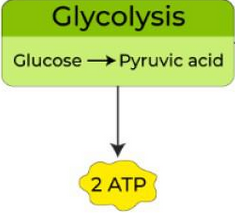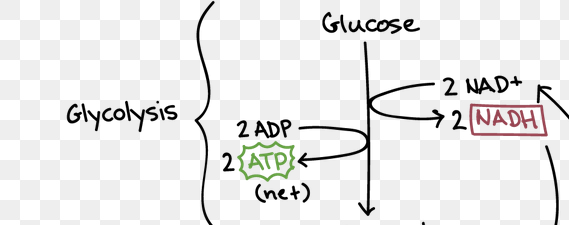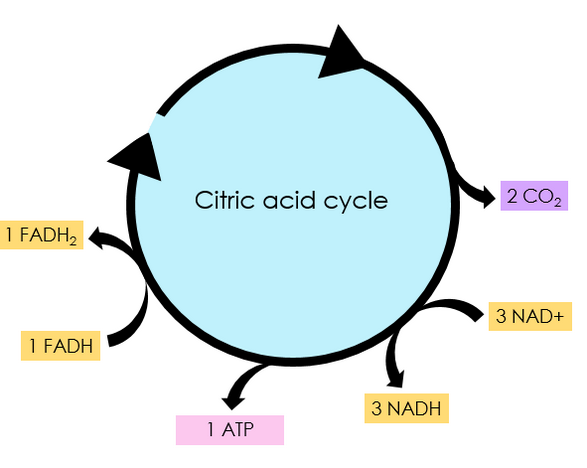Nutrition, Metabolism, & Energy Balance
1/65
Earn XP
Description and Tags
Ch 24 - Human Anatomy & Physiology
Name | Mastery | Learn | Test | Matching | Spaced |
|---|
No study sessions yet.
66 Terms
Where in the cell does glycolysis occur?
Cytosol of the cell is where glycolysis occurs
How much net ATP are produced per glucose molecule in glycolysis?
2 ATP (net) are produced per glucose molecule

How many ADH are produced per glucose molecule in glycolysis?
2 NADH are produced per glucose molecule

What is the end product of glycolysis?
2 Pyruvates are the end products of glycolysis
What is the “committed step” of glycolysis and what enzyme catalyzes it?
Committed step = phosphorylation of Fructose-6-phosphate to Fructose-1, 6-biphosphate. Catalyzed by enzyme phosphofructokinase (PFK).
What are the 2 phases of glycolysis?
The Energy Investment Phase (uses 2 ATP), Energy Payoff Phase (produces 2 ATP and 4 NADH).
What’s occurring during the Energy Investment Phase?
The cell uses 2 ATP molecules to phosphorylate Glucose to G6P then to F6P. Then F6P is phosphorylated to Fructose-1,6-Biphosphate.
Why is glucose-6-phosphate considered the "committed first intermediate"?
G6P traps glucose in the cell and commits it to a metabolic pathway.
During glycolysis, what is 2 molecules is glucose ultimately SPLIT into before they are converted to pyruvate?
Two 3-carbon molecules of Glyceraldehyde-3-Phosphate (G3P)
Where in the cell does the Citric Acid Cycle (Krebs Cycle) occur?
Within the mitochondial matrix.
What molecule must pyruvate be turned into before it can enter the Citric Acid Cycle?
Acetyl CoA
Name the 4-carbon molecule that accepts Acetyl CoA to start the Citric Acid Cycle
Oxaloacetate
What is the first product formed with Acetyl CoA and Oxaloacetate combine?
Citrate (Citric Acid)
How many NADH, FADH2, and ATP are produced in one turn of the Citric Acid Cycle per Acetyl CoA?
3 NADH, 1 FADH2, 1 ATP (or GTP).

What are the waste products of the Citric Acid Cycle?
2 CO2 per Acetyl CoA
What is the last chemical step of the cycle that re-creates the molecule you need to start the whole process over?
The conversion of malate into oxaloacetate. This is the step that "resets" the cycle.
How many “turns” of the Citric Acid Cycle occur per glucose molecule?
2 turns
What are the net products of the Citric Acid Cycle per glucose molecule?
4 CO₂, 6 NADH, 2 FADH2, 2 ATP
What is the primary function of the Citric Acid Cycle?
To harvest high-energy electrons from Acetyl CoA in the form of NADH and FADH2.
What is the process of forming new glucose from non-carbohydrate precursors? (lactate, glycerol, amino acids)
Gluconeogenesis
Where does gluconeogenesis primarily occur?
The liver (and to a lesser extent, the kidneys).
Name 3 major precursors for gluconeogenesis
Lactate, glycerol (from fats), and glucogenic amino acids
What is the process of breaking down glycogen into glucose?
Glycogenolysis
What is the process of synthesizing glycogen from glucose?
Glycogenesis
What is glycogen?
Glycogen is glucose in storage form; It's not a single glucose molecule, but a huge, branched chain of thousands of glucose molecules all linked together. This is why Glycogen can be used to synthesize glucose (glycogenesis) and why glycogen can be broken down into glucose (glycogenolysis).
In which organ can glycogenolysis release glucose directly into the blood stream?
The liver can release glucose directly into the bloodstream because it contains the enzyme glucose-6-phosphatase which removes the phosphate group, converting G6P into free glucose.
What is the primary hormonal trigger for glycogenolysis?
Glucagon. Released by pancrease to signal the liver to break down its glycogen stores (glycogenolysis) and release glucose into the blood, making it the primary trigger for this process.
What is the primary hormonal trigger for glycogenesis?
Insulin. Release by pancreas to lower blood sugar by telling cells to take in glucose and, crucially, telling the liver to convert that excess glucose into its storage form, glycogen (glycogenesis)
What is the main goal of Oxidative Deamination?
To remove the amino group (-NH₂) from an amino acid, producing ammonia and a keto acid.
Which organ does Oxidative Deamination primarily occur?
The liver.
What is the name of the process where an amino group is transferred from one amino acid to a keto acid?
Transamination
What is the universal amino group acceptor in transamination reaction?
α-Ketoglutarate
Which molecule is the common product of transamination, that later undergoes oxidative deamination?
Glutamic Acid (glutamate)
What is the toxic waste product released from oxidative deamination, and what is it converted to for safe excretion?
Ammonia (NH3); converted to Urea
Where is the Electron Transport Chain (ETC) located?
The inner mitochondrial membrane (cristae)
What are the two primary inputs (fuels) for the Electron Transport Chain?
NADH & FADH2
What is the final electron acceptor at the end of the Electron Transport Chain?
O2, which forms H2O
What is the primary function of the ETC?
To create a proton (H+) gradient across the inner mitochondrial membrane. The proton gradient stores potential energy used to power enzyme ATP synthase.
What is the process of using a proton gradient to drive ATP synthesis called?
Chemiosmosis. After being actively pumped out to create the gradient, the H⁺ ions then move passively (by diffusion) back in through the ATP synthase channel. This passive flow of H⁺ is the "osmosis" of a chemical, hence chemiosmosis.
Name the enzyme that uses the proton gradient to make ATP?
ATP synthase
Approximately how many ATP are synthesized from the complete aerobic respiration of one glucose molecule?
~30-32 ATP
Why does FADH2 yield less ATP than NADH?
Because it passes its electrons directly to a carrier (CoQ) that is after the first proton-pumping site (Complex I). Complex I is Step 1 of the pump. It's a powerful pump that moves a lot of protons. FADH₂'s electrons miss the first pumping station (Complex I), so the total energy yield is lower (~1.5).
What is the metabolic state following a meal when nutrients are being absorbed and stored?
The Absorptive State
What is the dominant hormone of the absorptive state?
Insulin
List 3 anabolic (building) processes promoted by insulin.
Glycogenesis, Lipogenesis, and Protein Sythesis
What is the metabolic state between meals when the body must rely on internal food stores?
The Post-Absorptive (Fasting) State
What are the 2 dominant hormones of the post absorptive state?
Glucagon and Epinephrine
List 3 catabolic (breaking down) processes promoted by glucagon.
Glycogenolysis, Gluconeogenesis, & Lipolysis
What (organ) is maintaining blood glucose critical during the postabsorptive state?
Liver glycogenolysis and hepatic/renal gluconeogenesis.
What is the process of breaking down triglycerides into glycerol and fatty acids?
Lypolysis.
What is the process of breaking down fatty acids into multiple Acetyl CoA molecules?
Beta-Oxidation
Where does beta-oxidation occur?
The mitochondrial matrix
What is the name of the condition where excess Acetyl CoA from fat breakdown is converted into ketone bodies?
Ketosis
What are the 3 types of ketone bodies?
Acetoacetate, Beta-hydroxybutyrate, Acetone.
Why is ketosis dangerous in extreme cases (e.g., diabetic ketoacidosis)?
Ketone bodies are acids, and high levels can cause a dangerous drop in blood pH (acidosis).
List 4 key metabolic functions of the liver.
ANY: Glycogenesis/Glycogenolysis, Gluconeogenesis, Urea synthesis, Beta-oxidation, Lipoprotein synthesis, Bile production, Drug/toxin detoxification.
What critical nitrogenous waste products does the liver produce from ammonia?
Urea.
After a protein-rich meal, what does the liver do with excess amino acids?
It deaminates them, uses the carbon skeletons for energy or fat synthesis, and converts the nitrogen to urea.
Define Metabolism
The sum of all chemical reactions in the body
Define Anabolism
Metabolic pathways that build complex molecules from simpler ones (energy-requiring).
Define Catabolism
Metabolic pathways that break down complex molecules into simpler ones (energy-releasing).
What is BMR (basal metabolic rate)?
The body’s rate of energy expenditure at rest to maintain vital functions.
What is Negative Nitrogen Balance?
When nitrogen excretion exceeds nitrogen intake, indicating the body is breaking down more protein than it’s synthesizing (e.g. starvation, stress).
What is the primary role of Glucose in the body?
Glucose serves as the body’s preferred and most readily available fuel for cellular ATP production.
What is Acetyl CoA and why is it called the “Universal Metabolic Intermediate”?
Acetyl CoA is a 2-carbon molecule that is the common entry point into the Citric Acid Cycle for the oxidation of glucose, fatty acids, and amino acids.
What is the energy yield (kcal/gram) for carbohydrates, proteins, and fats?
Carbs: 4kcal/g, Protein: 4kcal/g, Fats: 9kcal/g.